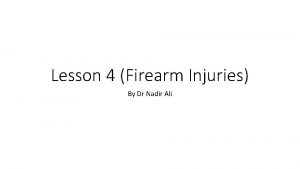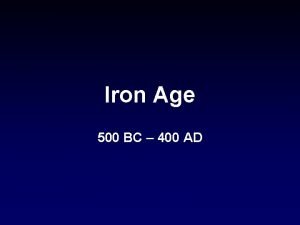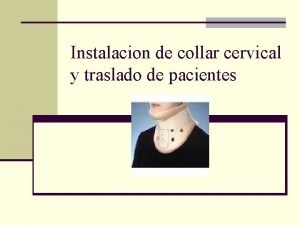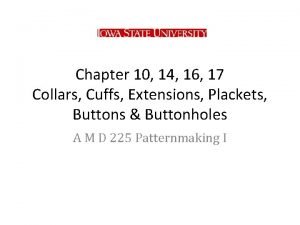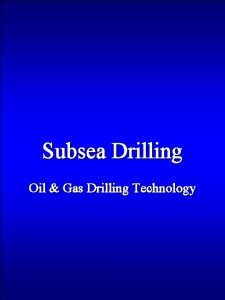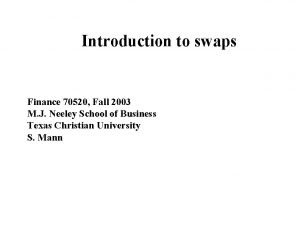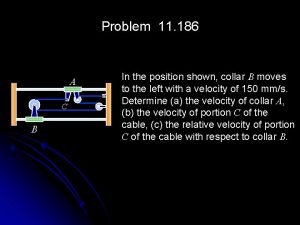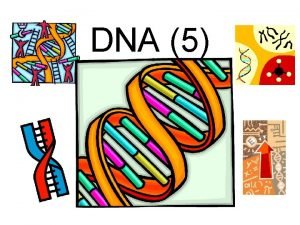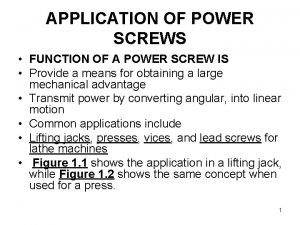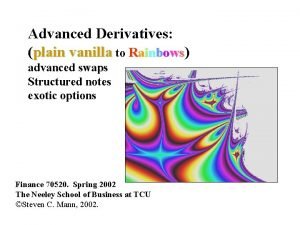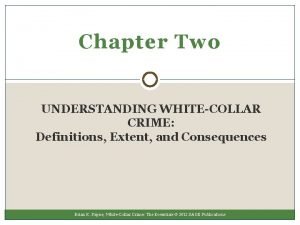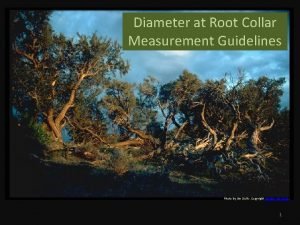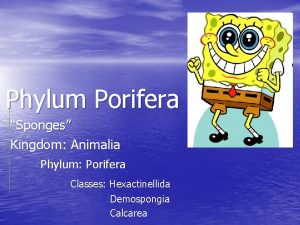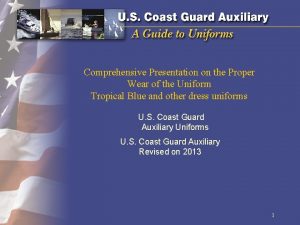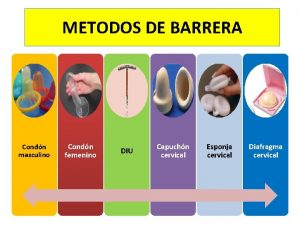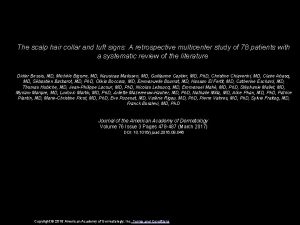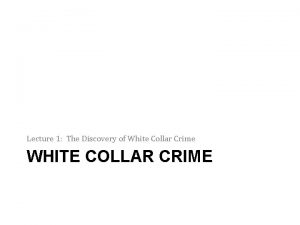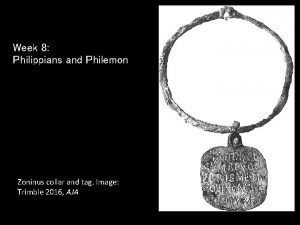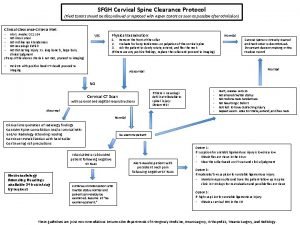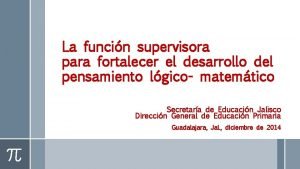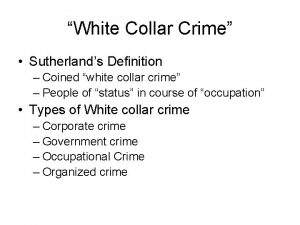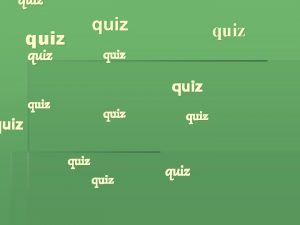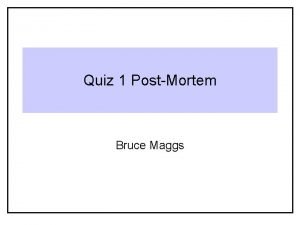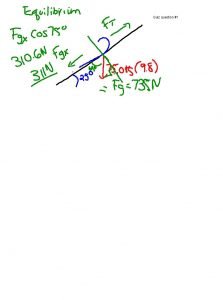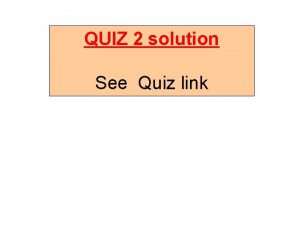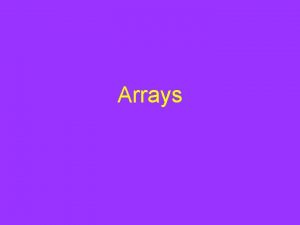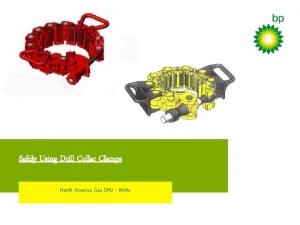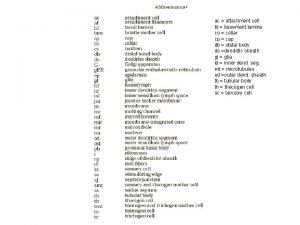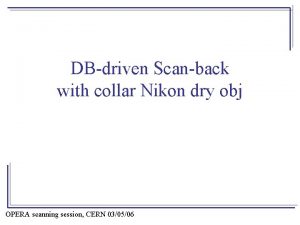QUIZ 4 The 2 kg collar is attached













































- Slides: 45

QUIZ 4 The 2 kg collar is attached to a spring that has an upstretched length of 2 m. If the collar is drawn to point B and released from rest, determine its speed when it arrives at point A. Mechanics for Engineers: Dynamics , 13 th SI Edition R. C. Hibbeler and Kai Beng Yap © Pearson Education South Asia Pte Ltd 2013. All rights reserved.

CHAPTER 12 PLANAR RIGID BODY MOTION: TRANSLATION & ROTATION Mechanics for Engineers: Dynamics , 13 th SI Edition R. C. Hibbeler and Kai Beng Yap © Pearson Education South Asia Pte Ltd 2013. All rights reserved.

APPLICATIONS (continued) Gears, pulleys and cams, which rotate about fixed axes, are often used in machinery to generate motion and transmit forces. The angular motion of these components must be understood to properly design the system. To do this design, we need to relate the angular motions of contacting bodies that rotate about different fixed axes. How is this different than the analyses we did in earlier chapters? Mechanics for Engineers: Dynamics , 13 th SI Edition R. C. Hibbeler and Kai Beng Yap © Pearson Education South Asia Pte Ltd 2013. All rights reserved.

RIGID BODY MOTION (Section 16. 1) There are cases where an object cannot be treated as a particle. In these cases the size or shape of the body must be considered. Rotation of the body about its center of mass requires a different approach. For example, in the design of gears, cams, and links in machinery or mechanisms, rotation of the body is an important aspect in the analysis of motion. We will now start to study rigid body motion. The analysis will be limited to planar motion. A body is said to undergo planar motion when all parts of the body move along paths equidistant from a fixed plane. Mechanics for Engineers: Dynamics , 13 th SI Edition R. C. Hibbeler and Kai Beng Yap © Pearson Education South Asia Pte Ltd 2013. All rights reserved.

PLANAR RIGID BODY MOTION There are three types of planar rigid body motion. Mechanics for Engineers: Dynamics , 13 th SI Edition R. C. Hibbeler and Kai Beng Yap © Pearson Education South Asia Pte Ltd 2013. All rights reserved.

PLANAR RIGID BODY MOTION (continued) Translation: Translation occurs if every line segment on the body remains parallel to its original direction during the motion. When all points move along straight lines, the motion is called rectilinear translation. When the paths of motion are curved lines, the motion is called curvilinear translation. Mechanics for Engineers: Dynamics , 13 th SI Edition R. C. Hibbeler and Kai Beng Yap © Pearson Education South Asia Pte Ltd 2013. All rights reserved.

PLANAR RIGID BODY MOTION (continued) Rotation about a fixed axis: In this case, all the particles of the body, except those on the axis of rotation, move along circular paths in planes perpendicular to the axis of rotation. General plane motion: In this case, the body undergoes both translation and rotation. Translation occurs within a plane and rotation occurs about an axis perpendicular to this plane. Mechanics for Engineers: Dynamics , 13 th SI Edition R. C. Hibbeler and Kai Beng Yap © Pearson Education South Asia Pte Ltd 2013. All rights reserved.

PLANAR RIGID BODY MOTION (continued) An example of bodies undergoing the three types of motion is shown in this mechanism. The wheel and crank undergo rotation about a fixed axis. In this case, both axes of rotation are at the location of the pins and perpendicular to the plane of the figure. The piston undergoes rectilinear translation since it is constrained to slide in a straight line. The connecting rod undergoes curvilinear translation, since it will remain horizontal as it moves along a circular path. The connecting rod undergoes general plane motion, as it will both translate and rotate. Mechanics for Engineers: Dynamics , 13 th SI Edition R. C. Hibbeler and Kai Beng Yap © Pearson Education South Asia Pte Ltd 2013. All rights reserved.

RIGID-BODY MOTION: TRANSLATION (Section 16. 2) The positions of two points A and B on a translating body can be related by r. B = r. A + r. B/A where r. A & r. B are the absolute position vectors defined from the fixed x-y coordinate system, and r. B/A is the relative-position vector between B and A. The velocity at B is v. B = v. A+ dr. B/A/dt. Now dr. B/A/dt = 0 since r. B/A is constant. So, v. B = v. A, and by following similar logic, a. B = a. A. Note, all points in a rigid body subjected to translation move with the same velocity and acceleration. Mechanics for Engineers: Dynamics , 13 th SI Edition R. C. Hibbeler and Kai Beng Yap © Pearson Education South Asia Pte Ltd 2013. All rights reserved.

RIGID-BODY MOTION: ROTATION ABOUT A FIXED AXIS (Section 16. 3) When a body rotates about a fixed axis, any point P in the body travels along a circular path. The angular position of P is defined by . The change in angular position, d , is called the angular displacement, with units of either radians or revolutions. They are related by 1 revolution = (2 ) radians Angular velocity, , is obtained by taking the time derivative of angular displacement: = d /dt (rad/s) + Similarly, angular acceleration is = d 2 /dt 2 = d /dt or Mechanics for Engineers: Dynamics , 13 th SI Edition R. C. Hibbeler and Kai Beng Yap = (d /d ) rad/s 2 + © Pearson Education South Asia Pte Ltd 2013. All rights reserved.

RIGID-BODY MOTION: ROTATION ABOUT A FIXED AXIS (continued) If the angular acceleration of the body is constant, = C, the equations for angular velocity and acceleration can be integrated to yield the set of algebraic equations below. = 0 + C t = 0 + 0 t + 0. 5 C t 2 2 = ( 0)2 + 2 C ( – 0) 0 and 0 are the initial values of the body’s angular position and angular velocity. Note these equations are very similar to the constant acceleration relations developed for the rectilinear motion of a particle. Mechanics for Engineers: Dynamics , 13 th SI Edition R. C. Hibbeler and Kai Beng Yap © Pearson Education South Asia Pte Ltd 2013. All rights reserved.

RIGID-BODY ROTATION: VELOCITY OF POINT P The magnitude of the velocity of P is equal to r (the text provides the derivation). The velocity’s direction is tangent to the circular path of P. In the vector formulation, the magnitude and direction of v can be determined from the cross product of w and rp. Here rp is a vector from any point on the axis of rotation to P. v = w × rp = w × r The direction of v is determined by the right-hand rule. Mechanics for Engineers: Dynamics , 13 th SI Edition R. C. Hibbeler and Kai Beng Yap © Pearson Education South Asia Pte Ltd 2013. All rights reserved.

RIGID-BODY ROTATION: ACCELERATION OF POINT P The acceleration of P is expressed in terms of its normal (an) and tangential (at) components. In scalar form, these are at = r and an = 2 r. The tangential component, at, represents the time rate of change in the velocity's magnitude. It is directed tangent to the path of motion. The normal component, an, represents the time rate of change in the velocity’s direction. It is directed towards the center of the circular path. Mechanics for Engineers: Dynamics , 13 th SI Edition R. C. Hibbeler and Kai Beng Yap © Pearson Education South Asia Pte Ltd 2013. All rights reserved.

RIGID-BODY ROTATION: ACCELERATION OF POINT P (continued) Using the vector formulation, the acceleration of P can also be defined by differentiating the velocity. a = dv/dt = dw/dt × r. P + = a × r. P + w × dr. P/dt w × ( w × r. P ) It can be shown that this equation reduces to a= a × r – 2 r = at + an The magnitude of the acceleration vector is a = Mechanics for Engineers: Dynamics , 13 th SI Edition R. C. Hibbeler and Kai Beng Yap (at)2 + (an)2 © Pearson Education South Asia Pte Ltd 2013. All rights reserved.

ROTATION ABOUT A FIXED AXIS: PROCEDURE • Establish a sign convention along the axis of rotation. • If a relationship is known between any two of the variables ( , , , or t), the other variables can be determined from the equations: = d /dt d = d • If is constant, use the equations for constant angular acceleration. • To determine the motion of a point, the scalar equations v = r, at = r, an = 2 r, and a = (at)2 + (an)2 can be used. • Alternatively, the vector form of the equations can be used (with i, j, k components). v = w × r. P = w × r a = at + an = a × r. P + w × (w × r. P) = a × r – 2 r Mechanics for Engineers: Dynamics , 13 th SI Edition R. C. Hibbeler and Kai Beng Yap © Pearson Education South Asia Pte Ltd 2013. All rights reserved.

EXAMPLE Given: The motor turns gear A with a constant angular acceleration, A = 4. 5 rad/s 2, starting from rest. The cord is wrapped around pulley D which is rigidly attached to gear B. Find: The velocity of cylinder C and the distance it travels in 3 seconds. Plan: 1) The angular acceleration of gear B (and pulley D) can be related to A. 2) The acceleration of cylinder C can be determined by using the equations of motion for a point on a rotating body since (at)D at point P is the same as ac. 3) The velocity and distance of C can be found by using the constant acceleration equations. Mechanics for Engineers: Dynamics , 13 th SI Edition R. C. Hibbeler and Kai Beng Yap © Pearson Education South Asia Pte Ltd 2013. All rights reserved.

EXAMPLE (continued) Solution: 1) Gear A and B will have the same speed and tangential component of acceleration at the point where they mesh. Thus, at = Ar. A = Br. B (4. 5)(75) = B(225) B = 1. 5 rad/s 2 Since gear B and pulley D turn together, D = B = 1. 5 rad/s 2 2) Assuming the cord attached to pulley D is inextensible and does not slip, the velocity and acceleration of cylinder C will be the same as the velocity and tangential component of acceleration along the pulley D. a. C = (at)D = D r. D = (1. 5)(0. 125) = 0. 1875 m/s 2 Mechanics for Engineers: Dynamics , 13 th SI Edition R. C. Hibbeler and Kai Beng Yap © Pearson Education South Asia Pte Ltd 2013. All rights reserved.

EXAMPLE (continued) 3) Since A is constant, D and a. C will be constant. The constant acceleration equation for rectilinear motion can be used to determine the velocity and displacement of cylinder C when t = 3 s (s 0= v 0 = 0): vc = v 0 + a. C t = 0 + 0. 1875 m/s 2(3 s) = 0. 563 m/s sc = s 0 + v 0 t + (0. 5) a. C t 2 = 0 + (0. 5) 0. 1875 m/s 2 (3 s)2 = 0. 844 m Mechanics for Engineers: Dynamics , 13 th SI Edition R. C. Hibbeler and Kai Beng Yap © Pearson Education South Asia Pte Ltd 2013. All rights reserved.

PROBLEM SOLVING Given: Gear A is given an angular acceleration A= 4 t 3 rad/s 2, where t is in seconds, and ( A)0= 20 rad/s. Find: The angular velocity and angular displacement of gear B when t = 2 s. Plan: 1) Apply the kinematic equation of variable angular acceleration to find the angular velocity of gear A. 2) Find the relationship of angular motion between gear A and gear B in terms of time and then use 2 s. Mechanics for Engineers: Dynamics , 13 th SI Edition R. C. Hibbeler and Kai Beng Yap © Pearson Education South Asia Pte Ltd 2013. All rights reserved.

PROBLEM SOLVING (continued) Solution: 1) Motion of Gear A : Applying the kinematic equation Mechanics for Engineers: Dynamics , 13 th SI Edition R. C. Hibbeler and Kai Beng Yap © Pearson Education South Asia Pte Ltd 2013. All rights reserved.

PROBLEM SOLVING (continued) 2) Since gear B meshes with gear A, B = 36 (0. 05 / 0. 15) = 12 rad/s B = 46. 4 (0. 05 / 0. 15) = 15. 5 rad Mechanics for Engineers: Dynamics , 13 th SI Edition R. C. Hibbeler and Kai Beng Yap © Pearson Education South Asia Pte Ltd 2013. All rights reserved.

ABSOLUTE MOTION ANALYSIS Mechanics for Engineers: Dynamics , 13 th SI Edition R. C. Hibbeler and Kai Beng Yap © Pearson Education South Asia Pte Ltd 2013. All rights reserved.

APPLICATIONS The large window is opened using a hydraulic cylinder AB. The position B of the hydraulic cylinder rod is related to the angular position, , of the window. A designer has to relate the translational velocity at B of the hydraulic cylinder and the angular velocity and acceleration of the window? How would you go about the task? Mechanics for Engineers: Dynamics , 13 th SI Edition R. C. Hibbeler and Kai Beng Yap © Pearson Education South Asia Pte Ltd 2013. All rights reserved.

APPLICATIONS (continued) The position of the piston, x, can be defined as a function of the angular position of the crank, . By differentiating x with respect to time, the velocity of the piston can be related to the angular velocity, , of the crank. This is necessary when designing an engine. The stroke of the piston is defined as the total distance moved by the piston as the crank angle varies from 0 to 180°. How does the length of crank AB affect the stroke? Mechanics for Engineers: Dynamics , 13 th SI Edition R. C. Hibbeler and Kai Beng Yap © Pearson Education South Asia Pte Ltd 2013. All rights reserved.

ABSOLUTE MOTION ANALYSIS (Section 16. 4) The figure below shows the window using a hydraulic cylinder AB. The absolute motion analysis method relates the position of a point, B, on a rigid body undergoing rectilinear motion to the angular position, , of a line contained in the body. Once a relationship in the form of s. B = f ( ) is established, the velocity and acceleration of point B are obtained in terms of the angular velocity and angular acceleration of the rigid body by taking the first and second time derivatives of the position function. Usually the chain rule must be used when taking the derivatives of the position coordinate equation. Mechanics for Engineers: Dynamics , 13 th SI Edition R. C. Hibbeler and Kai Beng Yap © Pearson Education South Asia Pte Ltd 2013. All rights reserved.

PROCEDURE FOR ABSOLUTE MOTION ANALYSIS The velocity and acceleration of a point undergoing rectilinear motion can be related to the angular velocity and angular acceleration of a line contained within a body using the following procedure. 1. Locate point on the body using position coordinate s, which is measured from a fixed origin. 2. From a fixed reference line, measure the angular position of a line lying in the body. Using the dimensions of the body, relate s to , e. g. , s = f( ). 3. Take the first time derivative of s = f( ) to get a relationship between v and . 4. Take the second time derivative to get a relationship between a and . Mechanics for Engineers: Dynamics , 13 th SI Edition R. C. Hibbeler and Kai Beng Yap © Pearson Education South Asia Pte Ltd 2013. All rights reserved.

EXAMPLE I Given: Crank AB rotates at a constant velocity of rad/s. Find: The velocity of point P when Plan: Define x as a function of respect to time. Mechanics for Engineers: Dynamics , 13 th SI Edition R. C. Hibbeler and Kai Beng Yap = 150 = 30°. and differentiate with © Pearson Education South Asia Pte Ltd 2013. All rights reserved.

EXAMPLE I (continued) Solution: x. P = 0. 2 cos + (0. 75)2 – (0. 2 sin )2 v. P = -0. 2 sin + (0. 5)[(0. 75)2 – (0. 2 sin )2]-0. 5(-2)(0. 2 sin )(0. 2 cos ) v. P = -0. 2 sin – [0. 5(0. 2)2 sin 2 ] / At (0. 75)2 – (0. 2 sin )2 = 30°, = 150 rad/s and v. P = -18. 5 m/s = 18. 5 m/s Mechanics for Engineers: Dynamics , 13 th SI Edition R. C. Hibbeler and Kai Beng Yap © Pearson Education South Asia Pte Ltd 2013. All rights reserved.

RELATIVE MOTION ANALYSIS: VELOCITY Mechanics for Engineers: Dynamics , 13 th SI Edition R. C. Hibbeler and Kai Beng Yap © Pearson Education South Asia Pte Ltd 2013. All rights reserved.

APPLICATIONS As the slider block A moves horizontally to the left with v. A, it causes the link CB to rotate counterclockwise. Thus v. B is directed tangent to its circular path. Which link is undergoing general plane motion? Link AB or link BC? How can the angular velocity, , of link AB be found? Mechanics for Engineers: Dynamics , 13 th SI Edition R. C. Hibbeler and Kai Beng Yap © Pearson Education South Asia Pte Ltd 2013. All rights reserved.

APPLICATIONS (continued) Planetary gear systems are used in many automobile automatic transmissions. By locking or releasing different gears, this system can operate the car at different speeds. How can we relate the angular velocities of the various gears in the system? Mechanics for Engineers: Dynamics , 13 th SI Edition R. C. Hibbeler and Kai Beng Yap © Pearson Education South Asia Pte Ltd 2013. All rights reserved.

RELATIVE MOTION ANALYSIS (Section 16. 5) When a body is subjected to general plane motion, it undergoes a combination of translation and rotation. Point A is called the base point in this analysis. It generally has a known motion. The x’- y’ frame translates with the body, but does not rotate. The displacement of point B can be written: Disp. due to translation dr. B = dr. A + dr. B/A Disp. due to translation and rotation Disp. due to rotation Mechanics for Engineers: Dynamics , 13 th SI Edition R. C. Hibbeler and Kai Beng Yap © Pearson Education South Asia Pte Ltd 2013. All rights reserved.

RELATIVE MOTION ANALYSIS: VELOCITY The velocity at B is given as : (dr. B/dt) = (dr. A/dt) + (dr. B/A/dt) or v. B = v. A + v. B/A Since the body is taken as rotating about A, v. B/A = dr. B/A/dt = w × r. B/A Here w will only have a k component since the axis of rotation is perpendicular to the plane of translation. Mechanics for Engineers: Dynamics , 13 th SI Edition R. C. Hibbeler and Kai Beng Yap © Pearson Education South Asia Pte Ltd 2013. All rights reserved.

RELATIVE MOTION ANALYSIS: VELOCITY (continued) v. B = v. A + w × r. B/A When using the relative velocity equation, points A and B should generally be points on the body with a known motion. Often these points are pin connections in linkages. For example, point A on link AB must move along a horizontal path, whereas point B moves on a circular path. The directions of v. A and v. B are known since they are always tangent to their paths of motion. Mechanics for Engineers: Dynamics , 13 th SI Edition R. C. Hibbeler and Kai Beng Yap © Pearson Education South Asia Pte Ltd 2013. All rights reserved.

RELATIVE MOTION ANALYSIS: VELOCITY (continued) v. B = v. A + w × r. B/A When a wheel rolls without slipping, point A is often selected to be at the point of contact with the ground. Since there is no slipping, point A has zero velocity. Furthermore, point B at the center of the wheel moves along a horizontal path. Thus, v. B has a known direction, e. g. , parallel to the surface. Mechanics for Engineers: Dynamics , 13 th SI Edition R. C. Hibbeler and Kai Beng Yap © Pearson Education South Asia Pte Ltd 2013. All rights reserved.

PROCEDURE FOR ANALYSIS The relative velocity equation can be applied using scalar x and y component equations or via a Cartesian vector analysis. Scalar Analysis: 1. Establish the fixed x-y coordinate directions and draw a kinematic diagram for the body. Then establish the magnitude and direction of the relative velocity vector v. B/A. 2. Write the equation v. B = v. A + v. B/A. In the kinematic diagram, represent the vectors graphically by showing their magnitudes and directions underneath each term. 3. Write the scalar equations from the x and y components of these graphical representations of the vectors. Solve for the unknowns. Mechanics for Engineers: Dynamics , 13 th SI Edition R. C. Hibbeler and Kai Beng Yap © Pearson Education South Asia Pte Ltd 2013. All rights reserved.

PROCEDURE FOR ANALYSIS (continued) Vector Analysis: 1. Establish the fixed x - y coordinate directions and draw the kinematic diagram of the body, showing the vectors v. A, v. B, r. B/A and w. If the magnitudes are unknown, the sense of direction may be assumed. 2. Express the vectors in Cartesian vector form (CVN) and substitute them into v. B = v. A + w × r. B/A. Evaluate the cross product and equate respective i and j components to obtain two scalar equations. 3. If the solution yields a negative answer, the sense of direction of the vector is opposite to that assumed. Mechanics for Engineers: Dynamics , 13 th SI Edition R. C. Hibbeler and Kai Beng Yap © Pearson Education South Asia Pte Ltd 2013. All rights reserved.

EXAMPLE I Given: Roller A is moving to the right at 3 m/s. Find: The velocity of B at the instant = 30. Plan: 1. Establish the fixed x - y directions and draw a kinematic diagram of the bar and rollers. 2. Express each of the velocity vectors for A and B in terms of their i, j, k components and solve v. B = v. A + × r. B/A. Mechanics for Engineers: Dynamics , 13 th SI Edition R. C. Hibbeler and Kai Beng Yap © Pearson Education South Asia Pte Ltd 2013. All rights reserved. w

Solution: Kinematic diagram: EXAMPLE I (continued) y y Express the velocity vectors in CVN v. B = v. A + w × r. B/A -v. B j = 3 i + [ k × (-1. 5 cos 30 i +1. 5 sin 30 j)] -v. B j = 3 i – 1. 299 w j – 0. 75 i Equating the i and j components gives: 0 = 3 – 0. 75 w -v. B = – 1. 299 Solving: = 4 rad/s or w = 4 rad/s k v. B = 5. 2 m/s or v. B = -5. 2 m/s j Mechanics for Engineers: Dynamics , 13 th SI Edition R. C. Hibbeler and Kai Beng Yap © Pearson Education South Asia Pte Ltd 2013. All rights reserved.

EXAMPLE II Given: Crank rotates OA with an angular velocity of 12 rad/s. Find: The velocity of piston B and the angular velocity of rod AB. Plan: Notice that point A moves on a circular path. The directions of v. A is tangent to its path of motion. Draw a kinematic diagram of rod AB and use v. B = v. A + w. AB × r. B/A. Mechanics for Engineers: Dynamics , 13 th SI Edition R. C. Hibbeler and Kai Beng Yap © Pearson Education South Asia Pte Ltd 2013. All rights reserved.

Solution: EXAMPLE II (continued) Kinematic diagram of AB: Since crack OA rotates with an angular velocity of 12 rad/s, the velocity at A will be: v. A = -0. 3(12) i = -3. 6 i m/s Rod AB. Write the relative-velocity equation: v. B = v. A + w. AB × r. B/A AB k × (0. 6 cos 30 i − 0. 6 sin 30 j ) v. B j = -3. 6 i + 0. 5196 AB j + 0. 3 AB i v. B j = -3. 6 i + By comparing the i, j components: i: 0 = -3. 6 + 0. 3 AB w. AB = 12 rad/s j: v. B = 0. 5196 AB v. B = 6. 24 m/s Mechanics for Engineers: Dynamics , 13 th SI Edition R. C. Hibbeler and Kai Beng Yap © Pearson Education South Asia Pte Ltd 2013. All rights reserved.

PROBLEM SOLVING Given: The shaper mechanism is designed to give a slow cutting stroke and a quick return to a blade attached to the slider at C. The link AB is rotating at AB = 4 rad/s. Find: The velocity of the slider block C when = 60°. Plan: Notice that link AB rotates about a fixed point A. The directions of v. B is tangent to its path of motion. Draw a kinematic diagram of rod BC. Then, apply the relative velocity equations to the rod and solve for unknowns. Mechanics for Engineers: Dynamics , 13 th SI Edition R. C. Hibbeler and Kai Beng Yap © Pearson Education South Asia Pte Ltd 2013. All rights reserved.

PROBLEM SOLVING (continued) Solution: Since link AB is rotating at AB = 4 rad/s, the velocity at point B will be: v. B = 4 (300) = 1200 mm/s At = 60°, v. B = -1200 cos 30 i + 1200 sin 30 j = (-1039 i + 600 j) mm/s Draw a kinematic diagram of rod BC C v. C w. BC y x Notice that the slider block C has a horizontal motion. r. C/B 45° B v. B 30° Mechanics for Engineers: Dynamics , 13 th SI Edition R. C. Hibbeler and Kai Beng Yap © Pearson Education South Asia Pte Ltd 2013. All rights reserved.

PROBLEM SOLVING (continued) Solution continued: Apply the relative velocity equation in order to find the velocity at C. v. C = v. B + w. BC × r. C/B C v. C w. BC r. C/B y x 45° -v. C i = (- 1039 i + 600 j) + BC k × (-125 cos 45 i + 125 sin 45 j) -v. C i = ( 1039 B v. B 30° 125 BC sin 45)i + (600 125 BC cos 45)j Equating the i and j components yields: -v. C = 1039 125 BC sin 45 0 = 600 125 BC cos 45 BC = 4. 8 rad/s v. C = 1639 mm/s = 1639 mm/s Mechanics for Engineers: Dynamics , 13 th SI Edition R. C. Hibbeler and Kai Beng Yap © Pearson Education South Asia Pte Ltd 2013. All rights reserved.

Mechanics for Engineers: Dynamics , 13 th SI Edition R. C. Hibbeler and Kai Beng Yap © Pearson Education South Asia Pte Ltd 2013. All rights reserved.
 Beveling phenomenon
Beveling phenomenon The 2 kg collar is attached to a spring
The 2 kg collar is attached to a spring Chapter 31 apush
Chapter 31 apush Introduction to information systems 6th edition
Introduction to information systems 6th edition Metodos del collar
Metodos del collar Loughnashade trumpet
Loughnashade trumpet White collar workers examples
White collar workers examples Warhol.org
Warhol.org Collar formation in tablets
Collar formation in tablets Skirts in cast gold restoration
Skirts in cast gold restoration Collar button ulcer
Collar button ulcer Qué son las palabras agudas
Qué son las palabras agudas Collar de extricacion
Collar de extricacion Shirt collar extensions
Shirt collar extensions Cap floor e collar
Cap floor e collar Pola krah setali
Pola krah setali Wellshead collar
Wellshead collar Blue collar computing
Blue collar computing Illegal
Illegal Subsurface
Subsurface Collar button lesion
Collar button lesion Zero cost collar
Zero cost collar In the position shown collar b moves to the left
In the position shown collar b moves to the left White collar crime meaning
White collar crime meaning Blue collar worker examples
Blue collar worker examples Kejahatan kerah biru (blue collar crime)
Kejahatan kerah biru (blue collar crime) Power screw collar
Power screw collar Venturi mask vs face mask
Venturi mask vs face mask Metodos del collar
Metodos del collar Zero cost collar
Zero cost collar Yoke lamination
Yoke lamination Blue collar worker examples
Blue collar worker examples Characteristics of white-collar crime
Characteristics of white-collar crime Costless collar oil and gas
Costless collar oil and gas Collar diameter
Collar diameter Sponge animal
Sponge animal White and blue collar worker
White and blue collar worker Coast guard trops collar device placement
Coast guard trops collar device placement White-collar workers คือ
White-collar workers คือ O2 mask types
O2 mask types Metodos del collar
Metodos del collar Hair collar sign
Hair collar sign White collar crime meaning
White collar crime meaning Roman philippi
Roman philippi Aspen collar precautions
Aspen collar precautions Un collar se rompió mientras jugaban dos enamorados
Un collar se rompió mientras jugaban dos enamorados
